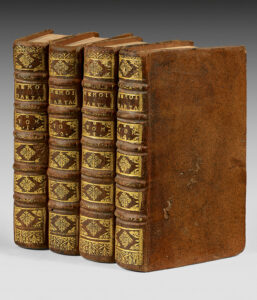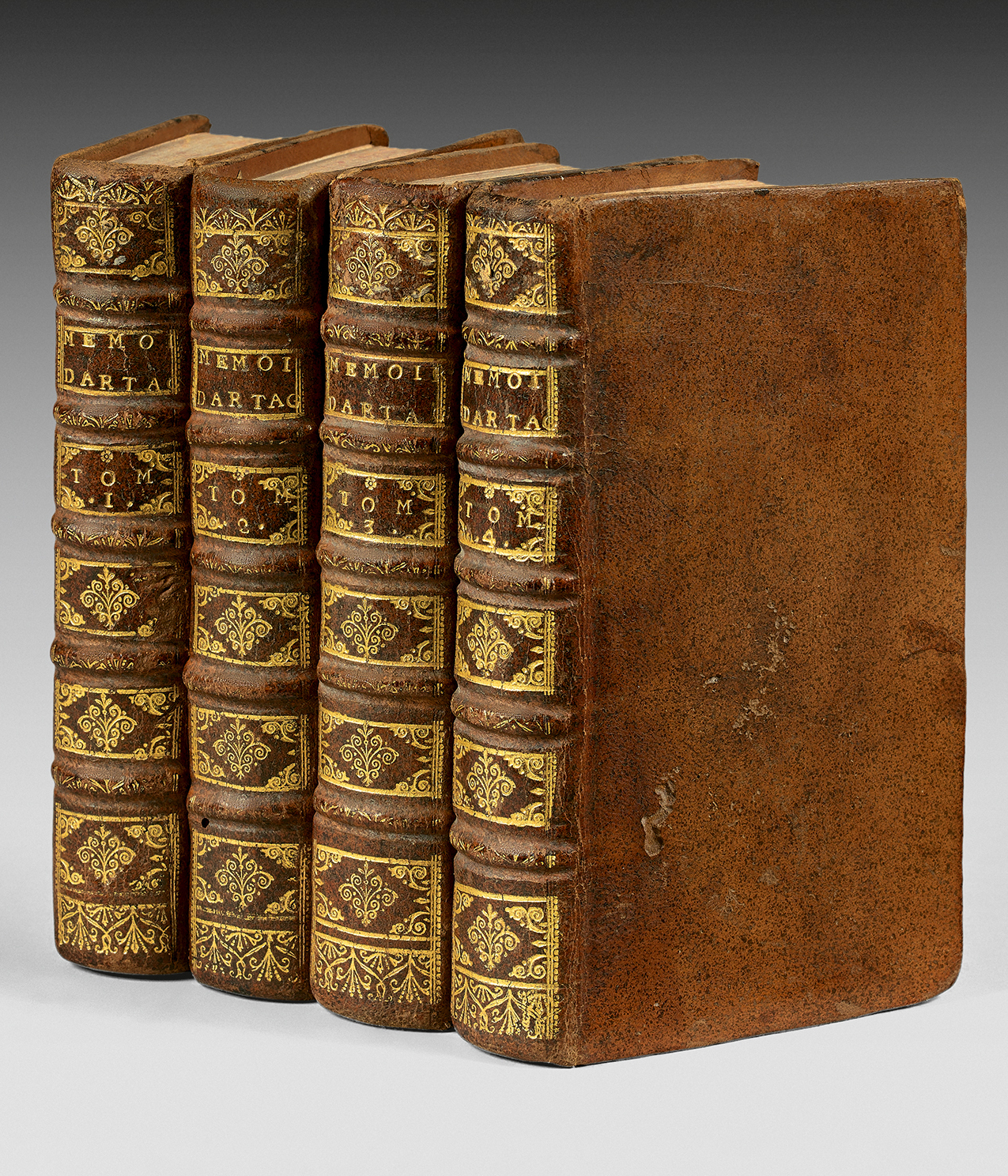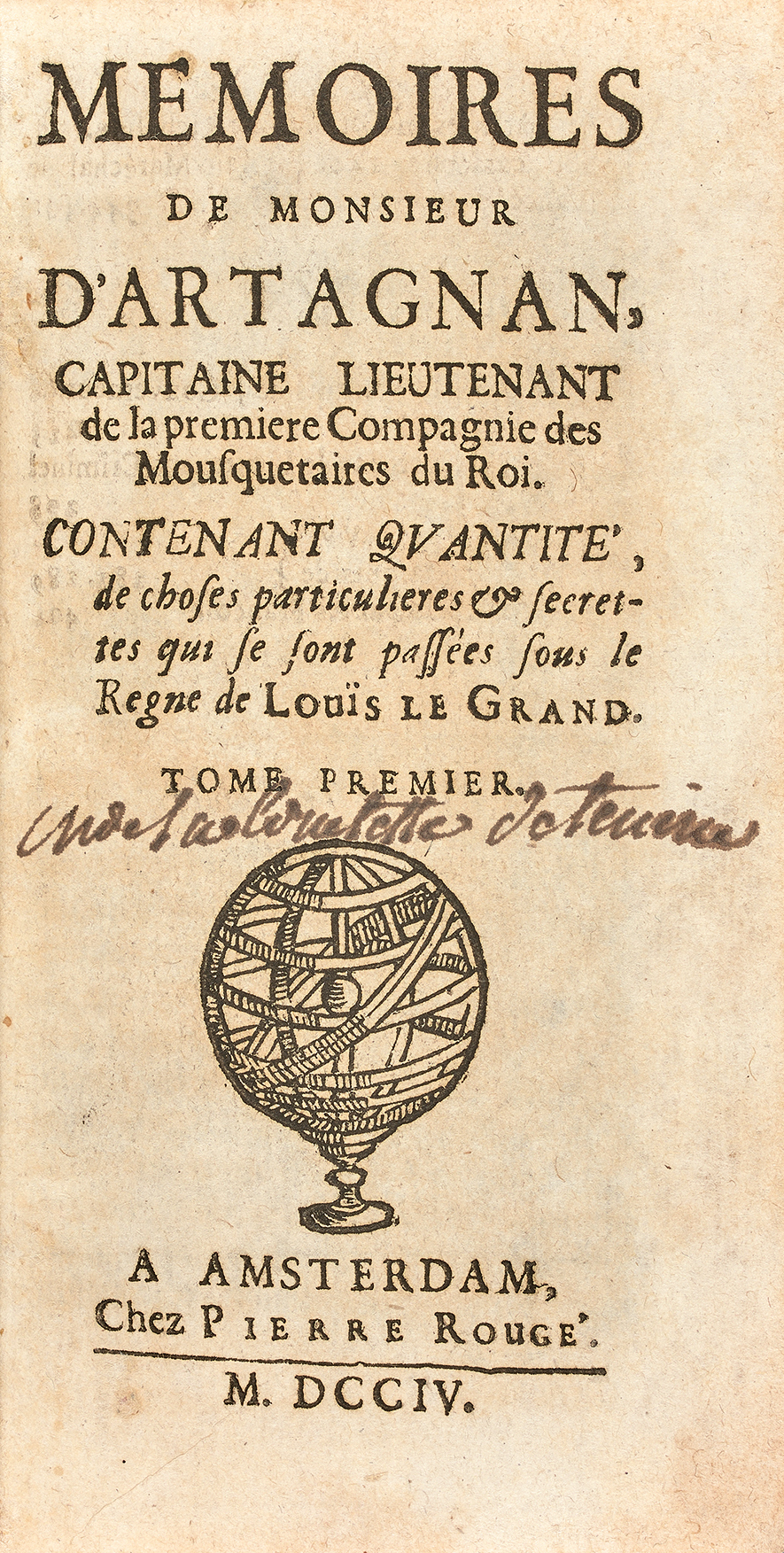Amsterdam, Pierre Rouge, 1700.
Four volumes in 12mo format, comprising:
- Volume I: (5) ll., including 1 portrait, 456 pp., (8) ll.; small tear without loss on p. 249.
- Volume II: 440 pp., (7) ll.; small strip of paper cut in the upper part of the title page.
- Volume III: 478 pp., (8) ll.
- Volume IV: 442 pp., (11) ll.; small strip of paper cut in the upper part of the title page.
Bound in full brown calf, with raised bands on the spine, gilt floral ornaments, and sprinkled edges.
Contemporary binding.
Dimensions: 147 x 80 mm.
Uncommon edition of this work, which inspired Dumas for Les Trois Mousquetaires. Courtilz de Sandras (1644–1712) was himself a musketeer before leaving the army to make a living through his writing.
Rare edition of this highly curious work (Jacob), the source of Alexandre Dumas’ famous Les Trois Mousquetaires.
“Alexandre Dumas skillfully drew inspiration from Courtilz de Sandras’ work for his novel Les Trois Mousquetaires. The names Athos, Porthos, and Aramis—so vividly picturesque—appear in full in the text; the duels, D’Artagnan’s romances, and his adventures with Milady are all genuinely recounted.” (Quérard)
“The Mémoires d’Artagnan prefigure the realistic novel, as Courtilz de Sandras crafted an appearance of historical authenticity to captivate readers. In the preface, he claims to have sourced his material from D’Artagnan’s personal papers.” (Dictionnaire des Auteurs, I, 699)
“Three authors contributed to Les Trois Mousquetaires: Gatien de Courtilz for the plot and intrigue; Maquet for the rough draft, framework, and groundwork; and Alexandre Dumas for narrative animation, dialogues, color, style, and vitality.” (Henri d’Alméras)
In The Mémoires de Monsieur d’Artagnan, , the myth of the humble nobleman playing a pivotal role in a perceived immutable social order takes shape.
Gatien de Courtilz, Sieur de Sandras (1644–1712), led a tumultuous life, largely due to his polemical writings.
“The boldness of his pen earned him twelve years in the Bastille.” (Quérard)
His works vividly depict the end of the Grand Siècle, brimming with anecdotes and scandals. The author allegedly wrote this book while imprisoned in the Bastille, where he had perhaps encountered D’Artagnan. In the fortress, censored and seized books were stored in an archive known as “L’Enfer,” which would eventually become “the most meticulously cataloged collection of prohibited works in the kingdom.” (Portier des Chartreux)
Despite seizures and bans, this text was often reprinted, elaborating upon the real-life story of Charles de Batz-Castelmore, Count of D’Artagnan (1600–1673), a musketeer serving Cardinal Mazarin.
The author had previously published a Testament Politique openly criticizing the absolutism of King Louis XIV.
With Les Mémoires de Monsieur d’Artagnan, Courtilz found another opportunity to critique the regime.
A precious copy from the library of the renowned Comtesse de Tencin.
Claudine-Alexandrine Guérin de Tencin, Baroness of Saint-Martin de l’Isle de Ré (1682–1749), was a French writer and salonnière, and mother of the philosopher d’Alembert.
After twenty-two years forced into convent life, she settled in Paris in 1711, rising in political circles through her connections with Cardinal Dubois. Six years later, she established one of the era’s most illustrious salons—initially focused on politics and finance, particularly with speculators from Law’s banking system. By 1733, it had evolved into a leading literary center. Prominent writers of the time frequented it, including Fontenelle, Marivaux, Abbé Prévost, Charles Pinot Duclos, Marmontel, Helvétius, Marie-Thérèse Geoffrin, and Montesquieu.
Madame de Tencin also successfully published several novels, including Les Mémoires du comte de Comminge en 1735, Le Siège de Calais, nouvelle historique en 1739 et Les Malheurs de l’amour en 1747.
“Following the Précieuses Ridicules of the 17th century, the Age of Enlightenment emerged—and Madame de Tencin’s salon epitomized this transition, intertwining political intrigue with the most audacious philosophical discussions. Claudine Guérin de Tencin (1682–1749) settled in Paris in 1711. As the Regent’s mistress, she navigated circles of power, establishing, in 1717, one of the most distinguished salons of the era. Initially focused on politics and finance, this bureau d’esprit later evolved into a literary and philosophical hub in 1733. The era’s greatest writers attended—Fontenelle, Marivaux, Abbé Prévost, Marmontel, and Montesquieu. Madame de Tencin was the mother of d’Alembert and a published author in her own right.” (Gallica)


